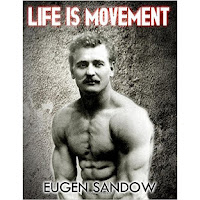I've seen a growing trend in the weight training world as of late: Attention to detail. It seems as if everyone wants to talk about the ideal time under load, what rep range to pick based on their fiber type, what philosophy book to read, what supplement to take, how many exercises to perform in a session, how many movements and sets per body part, etc. etc.
Some of these issues have merit, I suppose. However, in my opinion, the five following components will "make or break" your training success.
1) Consistency: You must train on a consistent basis. Training twice a month is not a consistent basis, nor will it bring any results. If you expect to get anything out of a routine, consistency is your first order of business. I think one can train hard 6-12 times monthly. The exact number will depend on your training level, age, job and family responsibilities etc. Allow enough time for recovery, but don't get carried away.
2) Overload Progression: You need to have some type of progression scheme. You must consistently overload your system, and the easiest way to do that is to lift more weight, or perform another rep. I don't care if you are training to failure using one set, training to failure using multiple sets, not training to failure, training with free weights, training with machines, training with rocks, training the Olympic lifts, or training in any other manner-YOU MUST FORCE YOUR BODY TO WORK AT PROGRESSIVELY HIGHER LEVELS. Basically, when I train, I want my body to say, "Oh shit!" That would be my definition of overload. If you don't train progressively, you are kidding yourself.
3) Desire: Quite simply, you have to want to train. If you are going to train, then train hard. Do not "play at it". A training session is not some kiddy scissors class. I don't know how many people I have seen come into a gym on a consistent basis, and consistently do nothing. You know the types I'm talking about. The people who will use the same weight on every exercise, for the same reps, time and time again. The ones who socialize, take a lot of water breaks, and otherwise do nothing. These individuals would be much better off going to Graeter's (a famous ice cream parlor here in Cincinnati) and eating ice cream...at least their heart would be in that.
4) Safety: If you can't perform a certain exercise safely, you are not going to perform it well, and therefore are not going to see many gains from that movement. I'm a big believer in the squat and deadlift. If one has the leverages, and their medical history allows, that individual should be performing these movements. When I talk about safety, I'm speaking in terms of the potential for injury...not the potential for experiencing discomfort. Feeling a certain amount of muscular discomfort during a compound joint exercise is inevitable. This is NOT a reason not to perform an exercise. Similarly, telling yourself "I'll just do leg presses in place of squats", when there is no reason you can't squat, is not an option. If one expects to get results, then one must be willing to bust his ass on movements which bring a large level of discomfort (squats, deadlift variations, presses, etc.).
5) KISS: Keep It Simple Stupid. Stop looking through the various research studies, seeking the perfect routine. You will not find the perfect routine now, nor will you find it in the future. Science has provided us with some good information when it comes to strength training...don't get me wrong. However, it is not going to provide the "Answer" to gaining size and strength. I've stated before that your common sense can take you a long way...so keep it simple. In a fairly recent conversation with Ted Lambrinides, he made the statement that "Strength training is more art than science." Agreed.
Train the largest muscular structures of the body with a limited number of compound exercises (and any isolation movements needed to prevent injury). Perform an exercise until you can no longer perform it. Squat until you don't rise from the bottom position. Press until the bar doesn't budge from your chest or shoulders. Deadlift until the bar doesn't come off the floor. Perform your reps in a controlled manner (do NOT count rep speed). Eat a variety of nutrients that allow for growth and recovery. Attempt to progress each workout. Leave the gym knowing you gave it your best on that particular day. Is this method "scientific"? No. Is it effective? You bet.
Until next month...TRAIN HARD.
Physical Culture Books.com
Vital Nutrition Store.com


